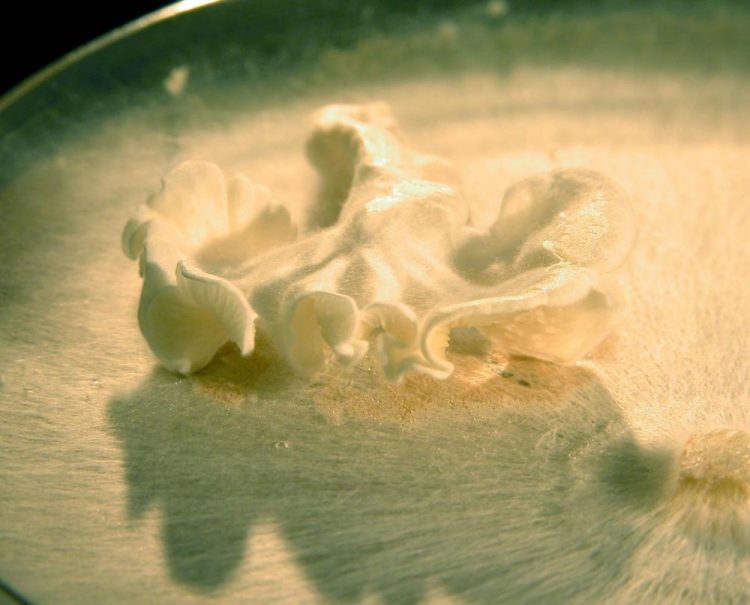Biology and chemistry combine to generate new antibiotics

Fruiting bodies from the mushroom Clitopilus passeckerianus generated in the laboratory. Credit: University of Bristol
With resistance growing to existing antibiotics, there is a vital and urgent need for the discovery and development of new antibiotics that are cost effective.
Promising developments are derivatives of the antibiotic pleuromutilin, with the core pleuromutilin isolated from the mushroom Clitopilus passeckerianus.
Pleuromutilin derivatives are potent antibacterial drugs but often require difficult chemical modifications.
In a new paper published today in Nature Communications, the Bristol team report the genetic characterisation of the steps involved in pleuromutilin biosynthesis through heterologous expression and generate a semi-synthetic pleuromutilin derivative with enhanced antibiotic activity.
This was achieved by taking the complete genetic pathway for pleuromutilin production, containing seven genes, from the mushroom, and rebuilding it in the industrially useful filamentous fungus Aspergillus oryzae, traditionally used to make soy sauce.
This then generated a unique platform of Aspergillus lines with combinations of the pathway genes to allow new compounds to be synthesized.
Professor Chris Willis, from the School of Chemistry, said: “This is a classic case where nature has produced something really useful, but combining nature with chemistry through a synthetic biology approach we are able to make things even better.”
These new compounds are some of the only new class of antibiotics to join the market recently as human therapeutics.
Furthermore, with their novel mode of action and lack of cross-resistance, pleuromutilins and their derivatives represent a class with further great potential, particularly for treating resistant strains such as methicillin-resistant Staphylococcus aureus (MRSA) and extensively drug resistant tuberculosis (XTB).
Professor Gary Foster from the School of Biological Sciences who led the team, with Dr Andy Bailey, added: “This research is very exciting as it also paves the way for future characterization of biosynthetic pathways of other basidiomycete natural products in ascomycete heterologous hosts.
“Many mushrooms have never even been examined and act as an untapped resource.
“The platform also opens up new possibilities of further chemical modification for the growing class of potent antibiotics.”
Media Contact
All latest news from the category: Life Sciences and Chemistry
Articles and reports from the Life Sciences and chemistry area deal with applied and basic research into modern biology, chemistry and human medicine.
Valuable information can be found on a range of life sciences fields including bacteriology, biochemistry, bionics, bioinformatics, biophysics, biotechnology, genetics, geobotany, human biology, marine biology, microbiology, molecular biology, cellular biology, zoology, bioinorganic chemistry, microchemistry and environmental chemistry.
Newest articles

Trotting robots reveal emergence of animal gait transitions
A four-legged robot trained with machine learning by EPFL researchers has learned to avoid falls by spontaneously switching between walking, trotting, and pronking – a milestone for roboticists as well…

Innovation promises to prevent power pole-top fires
Engineers in Australia have found a new way to make power-pole insulators resistant to fire and electrical sparking, promising to prevent dangerous pole-top fires and reduce blackouts. Pole-top fires pose…

Possible alternative to antibiotics produced by bacteria
Antibacterial substance from staphylococci discovered with new mechanism of action against natural competitors. Many bacteria produce substances to gain an advantage over competitors in their highly competitive natural environment. Researchers…





















